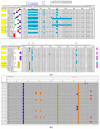Use of Targeted Amplicon Sequencing in Peanut to Generate Allele Information on Allotetraploid Sub-Genomes
- PMID: 33080972
- PMCID: PMC7650781
- DOI: 10.3390/genes11101220
Use of Targeted Amplicon Sequencing in Peanut to Generate Allele Information on Allotetraploid Sub-Genomes
Abstract
The use of molecular markers in plant breeding has become a routine practice, but the cost per accession can be a hindrance to the routine use of Quantitative Trait Loci (QTL) identification in breeding programs. In this study, we demonstrate the use of targeted re-sequencing as a proof of concept of a cost-effective approach to retrieve highly informative allele information, as well as develop a bioinformatics strategy to capture the genome-specific information of a polyploid species. SNPs were identified from alignment of raw transcriptome reads (2 × 50 bp) to a synthetic tetraploid genome using BWA followed by a GATK pipeline. Regions containing high polymorphic SNPs in both A genome and B genomes were selected as targets for the resequencing study. Targets were amplified using multiplex PCR followed by sequencing on an Illumina HiSeq. Eighty-one percent of the SNP calls in diploids and 68% of the SNP calls in tetraploids were confirmed. These results were also confirmed by KASP validation. Based on this study, we find that targeted resequencing technologies have potential for obtaining maximum allele information in allopolyploids at reduced cost.
Keywords: allopolyploid; heterozygous SNP calls; targeted resequencing; tetraploids.
Conflict of interest statement
The authors declare no conflict of interest.
Figures




Similar articles
-
Transcriptome Sequencing of Diverse Peanut (Arachis) Wild Species and the Cultivated Species Reveals a Wealth of Untapped Genetic Variability.G3 (Bethesda). 2016 Dec 7;6(12):3825-3836. doi: 10.1534/g3.115.026898. G3 (Bethesda). 2016. PMID: 27729436 Free PMC article.
-
Reduced-Cost Genotyping by Resequencing in Peanut Breeding Programs Using Tecan Allegro Targeted Resequencing V2.Genes (Basel). 2024 Oct 24;15(11):1364. doi: 10.3390/genes15111364. Genes (Basel). 2024. PMID: 39596564 Free PMC article.
-
Next-generation transcriptome sequencing, SNP discovery and validation in four market classes of peanut, Arachis hypogaea L.Mol Genet Genomics. 2015 Jun;290(3):1169-80. doi: 10.1007/s00438-014-0976-4. Epub 2015 Feb 7. Mol Genet Genomics. 2015. PMID: 25663138
-
Single Nucleotide Polymorphism Identification in Polyploids: A Review, Example, and Recommendations.Mol Plant. 2015 Jun;8(6):831-46. doi: 10.1016/j.molp.2015.02.002. Epub 2015 Feb 10. Mol Plant. 2015. PMID: 25676455 Review.
-
Application of genotyping by sequencing technology to a variety of crop breeding programs.Plant Sci. 2016 Jan;242:14-22. doi: 10.1016/j.plantsci.2015.04.016. Epub 2015 Apr 30. Plant Sci. 2016. PMID: 26566821 Review.
Cited by
-
CAPG: comprehensive allopolyploid genotyper.Bioinformatics. 2023 Jan 1;39(1):btac729. doi: 10.1093/bioinformatics/btac729. Bioinformatics. 2023. PMID: 36367243 Free PMC article.
References
-
- Mason A.S. Challenges of Genotyping Polyploid Species. In: Batley J., editor. Plant Genotyping. Methods in Molecular Biology (Methods and Protocols) Volume 1245. Humana Press; New York, NY, USA: 2015. pp. 161–168. - PubMed
-
- Hulse-Kemp A.M., Lemmk J., Plieske J., Ashrafi H., Buyyarapu R., Fang D.D., Frelichowski J., Giband M., Hague S., Hinze L.L., et al. Development of a 63K SNP Array for cotton and high-density mapping of intraspecific and interspecific populations of Gossypium spp. Genes|Genomes|Genet. 2015;5:1187–1209. doi: 10.1534/g3.115.018416. - DOI - PMC - PubMed
Publication types
MeSH terms
Associated data
LinkOut - more resources
Full Text Sources

